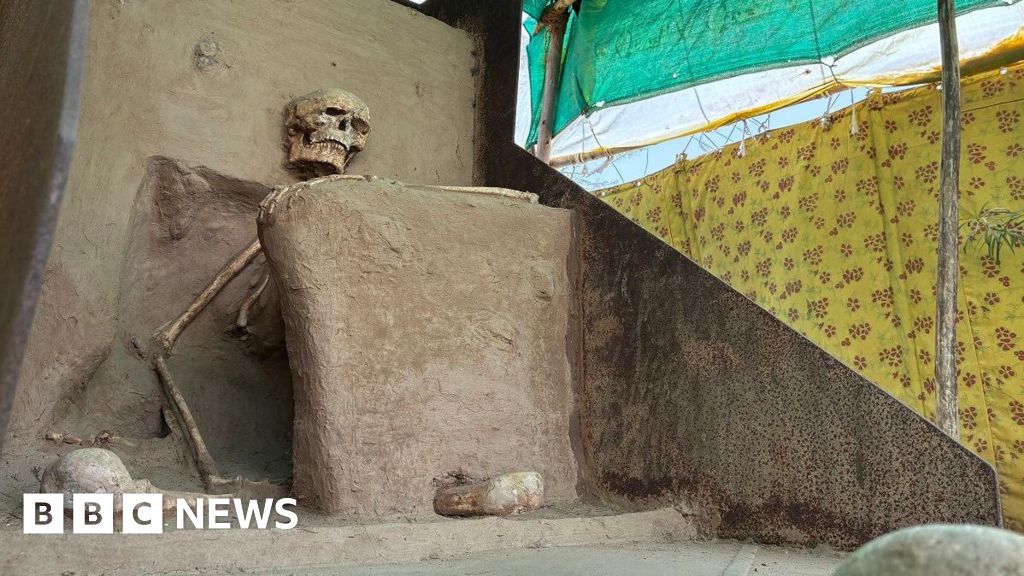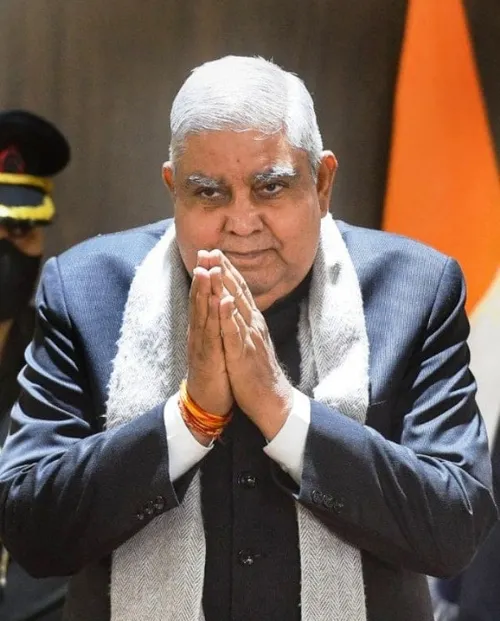BBC News, Mumbai
BBC Gujarati, Vadnagar
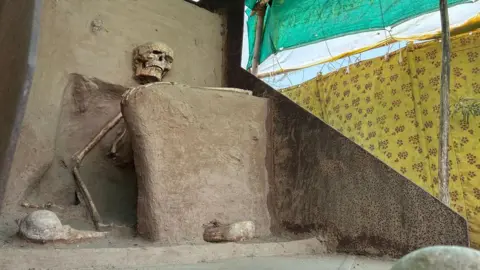 Kushal Batunge/BBC
Kushal Batunge/BBCA 1,000 year-old human skeleton buried sitting cross-legged in India is still without a museum to house it because of bureaucratic wrangling, six years after it was unearthed.
Archaeologist Abhijit Ambekar made the significant discovery in 2019, when he spotted what looked like the top of a human skull in western Gujarat state.
As his team dug deeper, they found the well-preserved remains in a pit in what appeared to be a meditative posture. Similar remains have been found at only three other sites in India.
But officials are still arguing over who should take charge of the skeleton. It remains in a makeshift shelter – not far from a new museum of local archaeology.
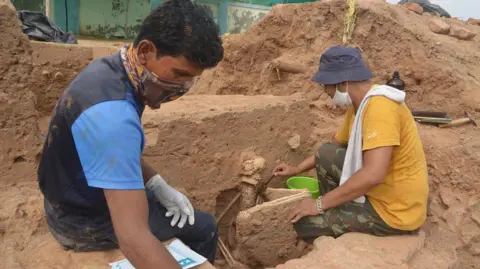 Bhakarba Thakor
Bhakarba ThakorAbhijit Ambekar says the skeleton – found in the town of Vadnagar – is likely to belong to the Solanki period. The Solanki dynasty, also known as the Chaulukya dynasty, ruled over parts of modern-day Gujarat between 940 to 1300 CE.
The skeleton’s right arm rested on its lap and its left arm lay suspended in the air, as if resting on a stick.
“The skeleton is an extremely valuable find, not just for Vadnagar but for the whole country. It can help us understand how our ancestors lived, and reveal details about the past that are yet unknown,” says Dr Ambekar, who heads the Archaeology Survey of India (ASI) division in Mumbai, and led the team that found the skeleton.
That it is yet to find a proper resting place, despite its archaeological significance, appears to come down to red tape.
Mr Ambekar says the Gujarat government’s plan for all artefacts excavated from Vadnagar was to place them in local museums.
He says around 9,000 artefacts, including the skeleton, that were excavated from Vadnagar between 2016 and 2022 by the ASI and had been handed over to the Gujarat government have been placed in local museums – except for the skeleton.
However, the state government says the skeleton is still in the possession of the ASI.
“As proper process was not followed, it [the skeleton] was not placed in the museum,” Pankaj Sharma, director of the state’s Directorate of Archaeology and Museums, told the BBC.
Yadubir Singh Rawat, director general of the ASI, did not respond to the BBC’s questions on the matter.
M Thennarasan, principal secretary of the state’s Sports, Youth and Cultural Activities Department told the BBC, that authorities were working on shifting the skeleton to a museum as soon as possible.
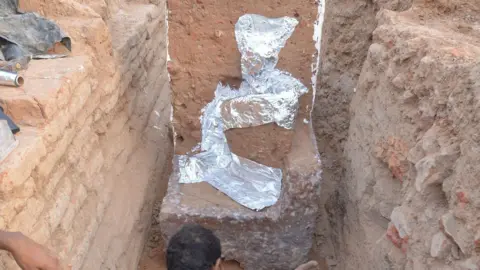 Bhakarba Thakor
Bhakarba ThakorExcavating the skeleton was a time-consuming process, Mr Ambekar says, adding that it took two months to complete. Various tools were used to carefully brush the soil away and free the skeleton from its ancient grave.
It is currently housed in a tarpaulin shelter in Vadnagar, unprotected by security guards and exposed to natural elements. Locals sometimes bring relatives and friends to see the skeleton – a curiosity that has put a spotlight on the town, which is also the birthplace of Prime Minister Narendra Modi.
What’s interesting is that just a short distance away is the new Archaeological Experiential Museum – inaugurated by India’s home minister in January.
According to a government press release, the museum has been built at a cost of $35m and is spread across 12,500 sq m. It boasts that it showcases “Vadnagar’s 2,500-year-old history with over 5,000 artefacts, including ceramics, coins, tools and skeletal remains”.
While the museum has a massive framed photo of the skeleton, it does not house the actual remains.
Vadnagar is a historically significant region in Gujarat and excavations by the ASI have found traces of human settlements dating back to more than 2,000 years ago. Mr Ambekar says that portions of an earthen rampart believed to have been built by the region’s first settlers exists even today.
Digs have also revealed remnants of ancient Buddhist monasteries and stupas. These findings and others – such as terracotta figurines, coins, shell jewellery and stone and copper plate inscriptions – have helped archaeologists establish seven cultural sequences or phases in the area, starting from around the 2nd Century BCE and dating all the way up to the 19th Century CE.
Mr Ambekar says the age of the skeleton he and his team found was estimated based on a DNA analysis of its teeth and a stratigraphic study of the excavation site. Stratigraphy involves studying rock sediments or layers of earth to determine their age. This is then used to establish the chronology of historical events or the approximate age of artefacts.
“The DNA analysis tells us that the skeleton is of local ancestry and belongs to a man in his forties, but more studies need to be done to understand his diet and lifestyle, which will in turn give us a better understanding of the region as it existed 1,000 years ago,” he says.
 Bhakarba Thakor
Bhakarba ThakorIt could also shed light on the phenomenon of “samadhi burials” – an ancient burial practice among Hindus where revered figures were buried instead of being cremated, Mr Ambekar says.
He adds that the skeleton had managed to survive the passage of time because the soil around it had remained undisturbed and displayed characteristics that prevent skeletal decay.
Extricating the skeleton from the site and moving it to its current location was not an easy task. First, a block of earth with the skeleton nestled inside was cut out from the soil surrounding it. The skeleton and soil were treated with different chemicals to consolidate their structures. The block of earth was then put into a wooden box filled with wet mud and a crane was used to move the box to its current site.
The entire operation took six days to complete, says Mr Ambekar.
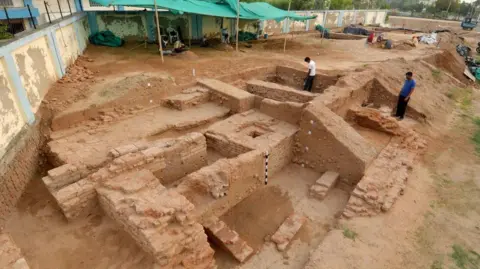 Bhakarba Thakor
Bhakarba ThakorHe hopes that the skeleton will find a place in a museum soon. But he adds it will need to have mechanisms to control the temperature and humidity of the space to prevent the skeleton from decomposing.
Locals the BBC spoke to expressed similar sentiments and blamed “red tapeism” for the back-and-forth over the skeleton.
“We are proud of Vadnagar’s ancient history but this treatment of a 1,000-year-old skeleton is deeply concerning. What is the point of building a museum if the most unique antiquity is left outside under a plastic roof?” Vadnagar resident Jesang Thakor said.
Another resident, Bethaji Thakor, said that he believed the skeleton could draw tourists from around the world to Vadnagar.
“Where else will you get to see something like this?”
Anurag Dhole is a seasoned journalist and content writer with a passion for delivering timely, accurate, and engaging stories. With over 8 years of experience in digital media, she covers a wide range of topics—from breaking news and politics to business insights and cultural trends. Jane's writing style blends clarity with depth, aiming to inform and inspire readers in a fast-paced media landscape. When she’s not chasing stories, she’s likely reading investigative features or exploring local cafés for her next writing spot.
